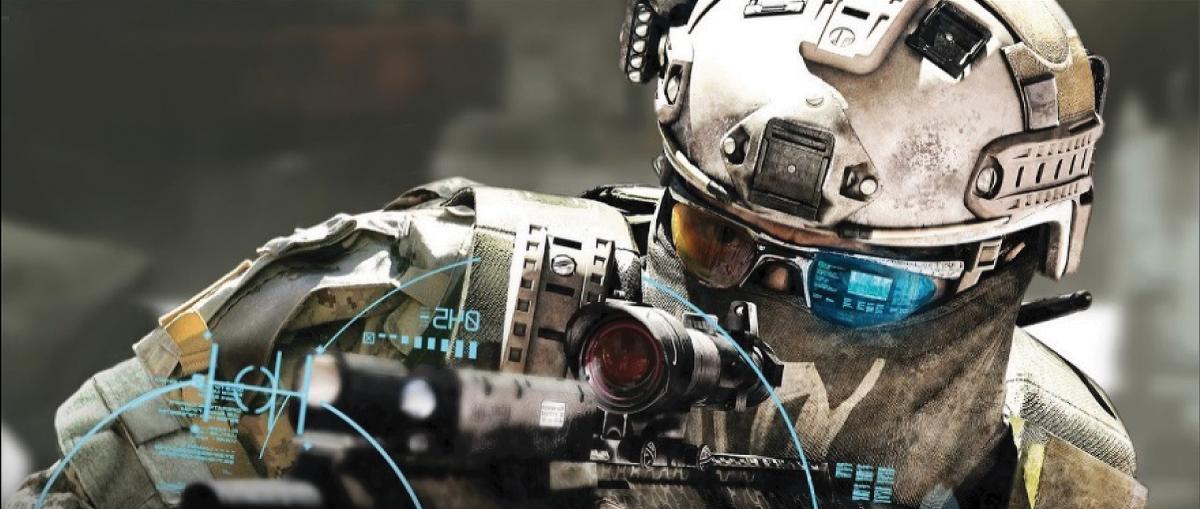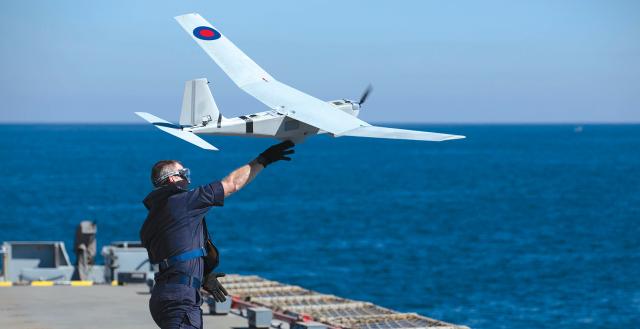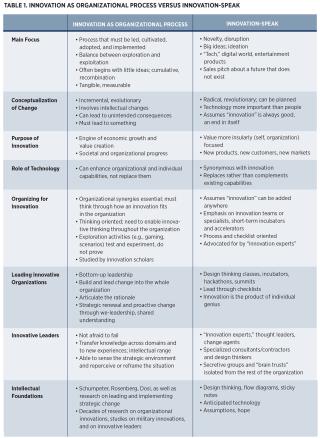General Anthony Zinni

Today’s strategic environment features rapid technological change coupled with the increasing accessibility of cutting-edge technologies to more and more actors. These changes, and the threats they pose to U.S. national security, span presidential administrations and cross party lines. The 2018 National Defense Strategy, for example, notes that maintaining U.S. technological advantage requires significant changes across the “National Security Innovation Base” and calls on the Department of Defense (DoD) to “organize for innovation” and “out-innovate revisionist powers.”1 In his Interim National Security Guidance, President Joe Biden pledges to “sustain America’s innovation edge” and encourages “the culture of innovation required to address today’s complex challenges.”2 Over the past several years, DoD has attempted to adapt to this dynamic technological landscape by establishing organizations and concepts such as the Defense Innovation Unit, the Chief Digital and AI Office, Joint All-Domain Command and Control, Project Convergence, Project Overmatch, the Rapid Defense Experimentation Reserve fund, and a network of “tech bridges” focused on leveraging artificial intelligence, machine learning, and other advancements to develop sensor networks and shorten kill chains.3
The 2018 National Defense Strategy specifically mentions China’s military modernization, which has been so massive in scale and rapid in speed, that it threatens the U.S. military’s technological edge. Innovation, therefore, is a must. Since before the Spanish-American War, innovation has been a key “way” of U.S. military strategy. Out-innovating our adversaries has been a hallmark of the U.S. military—think stealth, high-bandwidth communications, space-based intelligence, surveillance, and reconnaissance, and precision-guided munitions. But just as sea power was taken for granted after the end of the Cold War, the Pentagon’s ability to innovate faster than its adversaries became a given—one that is no longer. Witness China’s antiship ballistic missiles, hypersonic weapons program, informationized warfare, and military space capabilities. The imperative to innovate is back.
Integrating new technologies into U.S.warfighting capabilities is vital to national security. However, in today’s security discourse, innovation is often conflated with new technology and disruptive change, which leads to misunderstanding and misconceptions regarding innovation and a certain degree of “technologitis,” or overreliance on technology. In addition, there is an inclination to view new or big ideas as innovative by their very nature, although innovations often evolve from the accumulation of little ideas and combinations that are tested and refined over time.4 The iPhone, for example, was not a big new thing but rather a recombinant innovation. This tendency also overlooks the importance of people and the organizations in which they operate. Steve Jobs reminds us, “Technology is nothing. What’s important is that you have a faith in people, that they’re basically good and smart, and if you give them tools, they’ll do wonderful things with them. It’s not the tools that you have faith in—tools are just tools.”5
Often a new idea, concept, invention, or process deemed “innovative” is assumed to be indicative of progress or a “good” thing. People forget that Fortune named Enron “America’s most innovative company” six years in a row before its epic failure.6 Simply adding technology also is not always the right solution, and innovation should never be viewed as an end in itself. For militaries in particular, an overemphasis on technology can lead people to conclude that technological innovation matters more than tactical and organizational capabilities and competencies. It undervalues warfighters’ ability to think creatively and critically and act and lead decisively. The German military’s defeat of a technologically superior French military in a matter of six weeks in 1940 is a sobering reminder of the folly of this assumption.
New technology is important, but it is not a silver bullet solution that can be added at random when an organization confronts a challenge. Rather, it must be built into an organization’s capabilities, resources, and processes by collaborative, charismatic leaders who can think strategically, critically, and creatively but also encourage, lead, and manage teams to adopt, integrate, and maintain technologies over time. Military leaders must move beyond using “innovation” merely as a buzzword and establish a better understanding of what innovation is and is not, the organizational characteristics and features of innovation, what it takes to lead innovative organizations, and the traits and skills of innovative leaders.

An RQ-20 Puma unmanned aircraft is launched from the deck of a Royal Navy auxiliary ship. Regardless of the technology being introduced to the military, the individual user needs to understand the reasons behind its use to foster true innovation. Credit: U.S. Navy
An Organizational Process, Not a Buzzword
“Our infatuation with technology was a reflection of our own mirror imaging and an unrealistic desire to dictate the conduct of war on our own terms.”
General Al Gray, former Marine Corps Commandant, was a “we-leader” who led the Marine Corps to innovate and adapt maneuver warfare concepts. He encouraged direct, honest bottom-up feedback and ensured lessons were learned and incorporated into new tactics and doctrine. Credit: U.S. Naval Institute photo archive
An organization’s ability to innovate, adapt, learn, lead change, and ultimately survive depends on how well it balances “the exploration of new possibilities and the exploitation of old certainties.”7 Exploration entails discovery, experimentation, innovation, and play, whereas exploitation is more focused on efficiency, refinement, and executing existing processes. Steadily improving existing capabilities or products while exploring new opportunities and achieving breakthrough innovations is the hallmark of an “ambidextrous organization.”8 Today’s U.S. military service chiefs tend to frame this balancing act as one between maintaining military power and “legacy capabilities” that are available today and building the modern capabilities needed for the future competition. It often involves divesting “outdated” capabilities to invest in modernization efforts and “accelerate change.”9
Overemphasizing innovation, however, can blur the distinction between actual innovation and “innovation-speak.” Real innovation is managing the adaptive dilemma, adding value to organizations and society, and giving proper consideration to the processes and capabilities that are needed.10

Innovation-speak has created a market for easy recipes and checklist-style shortcuts that promise to help organizations innovate. Even if this were possible, it does not necessarily help with long-term adaptation or agility and can even work against it. It also can conceal some of the downsides or tradeoffs and, in the military, can lead to assumptions that ignore the fact that the enemy gets a vote in any fight. For example, a hyperfocus on “newness” or novelty can lead to the belief that most novel ideas are good or lead to good outcomes and thus overestimating the probability of success.11 DoD is littered with programs that have failed spectacularly due to this predisposition.12 Innovation-speak also can lead to the erroneous assumption that novelty is easy to implement. Former Defense Secretary Robert M. Gates, who laments the bureaucratic wars he constantly fought in the Pentagon, begs to differ.13
Real innovation is not simply an idea, but rather a process built into an organization. It is driven by the organization’s strategy and the need to address an empirical problem. It is led and implemented with an eye toward developing and exploring synergies with the organization’s capabilities, as well as for maintaining a balance between exploration and exploitation, even though each has the tendency to extinguish the other.14 It requires free and open inquiry and feedback mechanisms for learning and adapting, to help identify new strategies and organizational structures. Organizations must create new knowledge through a “continual dialogue between explicit and tacit knowledge” that “drives the creation of new ideas and concepts.”15
Tacit knowledge is created through socialization and bringing together shared experiences. This might include informal discussions immediately following an operation or exercise or discussions over beers after work. Tacit knowledge must be articulated into explicit knowledge in the form of a presentation, information paper, or article so it can be shared with others. Such forms of explicit knowledge are then collected, combined, and disseminated so they can be edited, tested, and promulgated by those in authority.
This vetted, explicit knowledge takes the form of doctrine, field manuals, and other training and instructional materials, which are then internalized by members of the organization to inform training. Their subsequent learning-by-doing embodies this knowledge in action and practice. This is an ongoing process, facilitated by activities such as gaming, scenarios, exercises, and experiments that emphasize free play and explore new paths to the future. The process prepares an organization to innovate and implement by building buy-in from the participants. It cultivates critical and innovative thinking skills and attitudes as members participate in “the gentle art of reperceiving” reality.16
Seemingly disruptive and revolutionary changes are often incremental, evolutionary, and organizational. The development of the Marine Corps’ Advanced Base Force, for example, took decades of agitation on the part of junior and midgrade officers in the Navy to repurpose Marine ships’ guard detachments for the advanced base mission.17 Similarly, the rise of U.S. special operations forces into the force of choice during the war on terrorism was a gradual evolution and uphill battle during the first 75 years of their existence.18 Incremental innovations might undermine the idea that innovation can be big and fast, but small steps ensure continuing strategic fit not only between the organization and its environment, but also between the resources and capabilities in the organization. Leaders who can sense and perceive changes in the environment also are needed to ensure this strategic fit and cultivate, build, and lead innovation in organizations.
Leading Innovation and Innovative Leaders
Given the rapid change in, and complexity of, today’s security environment, leaders must be able to sense the strategic environment, think creatively and critically, and transfer knowledge or skills from one domain or experience to a new and possibly unforeseen one. Leading innovative organizations thus requires involved leaders who are themselves learners who constantly seek feedback and collect ideas. This desire to learn necessitates a certain amount of humility, which should also inform how we think of leadership. While traditional notions of leadership focus on the role of the individual building and motivating a team, broadening the concept to include the leader, the followers, and the organization might prove more fruitful. Such “we-leadership” is selfless and is centered on nurturing collectivity, strengthening commitment to the organization, and inspiring and motivating people. As a result, leaders and followers become less concerned with their careers. We-leaders lead by intent and are less hierarchical in their thinking. They attract innovative thinkers and doers because they emphasize ideas over rank.19
Former Marine Corps Commandant General Alfred Gray embraced we-leadership. He took a bottom-up approach to explaining his rationale for, winning converts to, and teaching the core tenets of maneuver warfare to change the Marine Corps’ approach to warfare.20 Members of an organization need to feel part of what it is doing and be excited about the change. Otherwise, they will tend to respond with apprehension and resistance. As Commanding General, 2d Marine Division, Gray established the Maneuver Warfare Board to collect, codify, and spread ideas on maneuver warfare. The board consolidated relevant material for Marines to read and established professional study groups. At these sessions—which often took place after working hours—maneuver ideas were debated, and the tacit knowledge of the participants was pooled to inform and improve the organization. These debates spilled over into the pages of the Marine Corps Gazette, where they took explicit form. The ideas were then vetted in experiments before ultimately being incorporated into tactics, techniques, and procedures, doctrine, and service manuals.
General Gray sought to balance exploitation and exploration by making exercises “free-play” or “force-on-force” to make training environments more realistic. Exercises thus served as experiments rather than scripted or “canned” scenarios that simply validated concepts and desired capabilities or tested a unit’s ability to perform a list of tasks. To mitigate a “box-checking” mentality that is prone to risk aversion and doing just enough, commanders were forced to try to outwit their peers, since there were definite winners and losers.21 The competition remained open-ended, spurring innovative ideas and approaches as opposed to playing it safe and settling for accomplishing the minimum.
Seeking to mitigate risk aversion and fear of failure, General Gray emphasized process over result. During after-action reviews, he was always more concerned about why Marines did what they did (i.e., what they were thinking) rather than with what they did. He challenged and empowered his leaders to think through alternative outcomes, learn from their mistakes, and experience the merits of the maneuver philosophy firsthand. In doing so, he won converts who took ownership of the new warfighting philosophy. Marines also became more likely to think outside the box and take chances because they were given the grace to fail and had a collective commitment to improving the organization.
Implicit in learning from failure is the humility to admit one is wrong or that one’s ideas can improve with the ideas and input of others. General Gray embraced this humility by democratizing the after-action review process, breaking down traditional notions of hierarchy and nurturing an open and collaborative environment. Marines removed their rank insignia before gathering to reinforce the importance of ideas over rank, foster the free exchange of ideas, and empower junior Marines to speak up, trust their instincts, and correct those more senior. This helped build support for change throughout the organization because everyone was involved. It was the opposite of a select brain trust, so it cultivated a stronger sense of organizational belonging and identity.
General Gray also welcomed the input of outsiders, including notably retired Air Force Colonel John Boyd, a maverick who had been largely ostracized by his own service, and Bill Lind, a brash and outspoken legislative aide to Senators Robert Taft Jr. and Gary Hart. General Gray and other maneuverists considered even the most ardent critics useful in the knowledge-generation process and in improving their concepts and arguments. Thus, at the individual level, the freedom to learn from failure, encouraged by we-leadership, improves the cognitive skills of future leaders. At the organizational level, it empowers the organization to explore new possibilities, adapt, and innovate.
Build and Maintain Competitive Advantage
Innovation is an organizational process, central to developing and maintaining competitive advantages. Real innovation differs from innovation-speak along many important dimensions that would be helpful to remember the next time DoD announces another Hacking 4 Defense competition or small business outreach event that seemingly encourages innovation as an end in itself or as a niche undertaking that contributes tangentially to the mission. Real innovation entails more than untested ideas or helping new capabilities navigate the “valley of death.” Rather, real innovation must be tied to a strategy and focused on a particular problem or challenge. The possibility of peer-level conflict against China’s People’s Liberation Army should serve as that focusing function today.
To successfully innovate, all of DoD, not simply a small cadre of experts, must feel part of the effort, or change will inevitably be met with resistance. This requires leaders to articulate the rationale for change and develop and implement innovations. They must be able to blend new technology and capabilities with existing ones. Innovation inevitably involves failures along the way and requires continued evaluation and refinement.
Innovation is not something that can be planned or achieved quickly or by following prescribed checklists. Enduring organizational changes take significant time and effort. The road to progress is often messy, lengthy, meandering, and unpredictable, which is why everyone in the organization must understand the goal and why people are more important than technology.
No comments:
Post a Comment